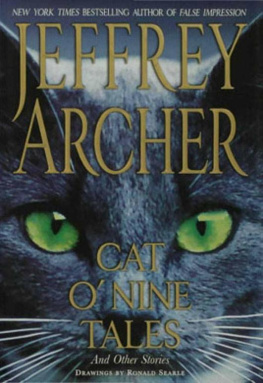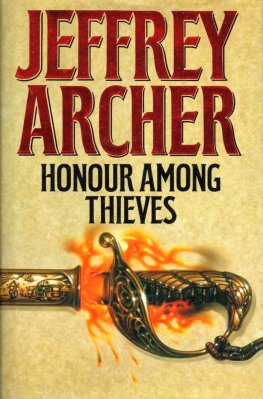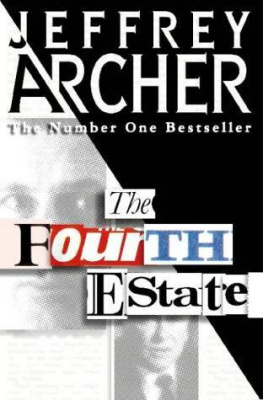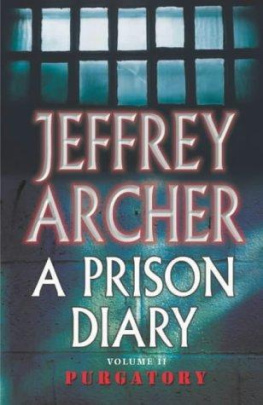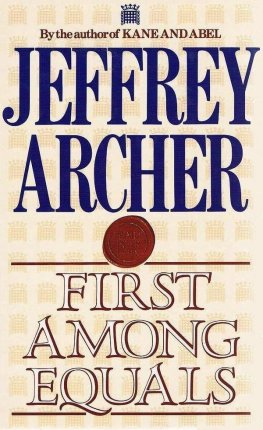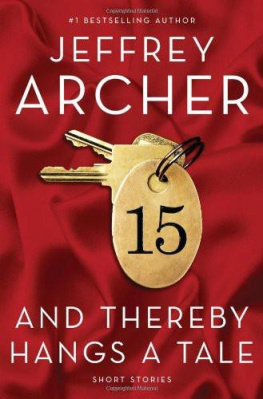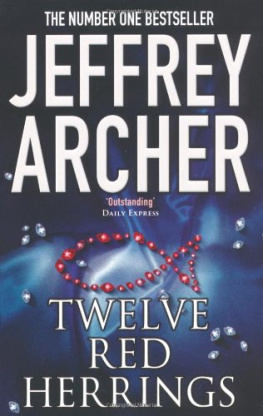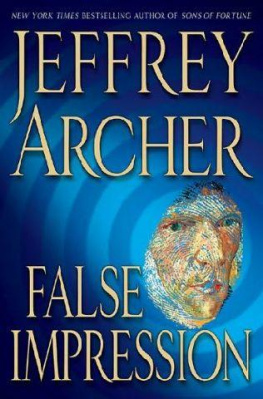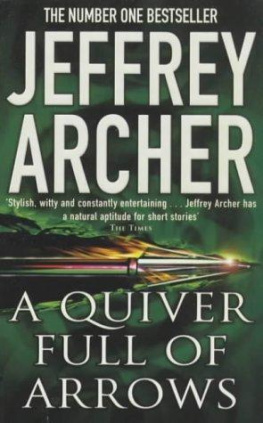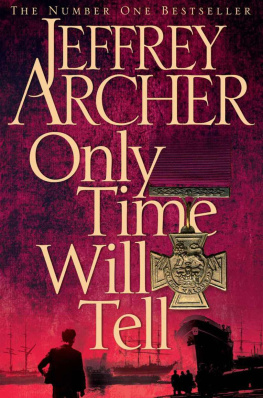Jeffrey Archer - Cat onine tales and other stories
Here you can read online Jeffrey Archer - Cat onine tales and other stories full text of the book (entire story) in english for free. Download pdf and epub, get meaning, cover and reviews about this ebook. year: 2007, publisher: St. Martins Press, genre: Detective and thriller. Description of the work, (preface) as well as reviews are available. Best literature library LitArk.com created for fans of good reading and offers a wide selection of genres:
Romance novel
Science fiction
Adventure
Detective
Science
History
Home and family
Prose
Art
Politics
Computer
Non-fiction
Religion
Business
Children
Humor
Choose a favorite category and find really read worthwhile books. Enjoy immersion in the world of imagination, feel the emotions of the characters or learn something new for yourself, make an fascinating discovery.
- Book:Cat onine tales and other stories
- Author:
- Publisher:St. Martins Press
- Genre:
- Year:2007
- Rating:5 / 5
- Favourites:Add to favourites
- Your mark:
- 100
- 1
- 2
- 3
- 4
- 5
Cat onine tales and other stories: summary, description and annotation
We offer to read an annotation, description, summary or preface (depends on what the author of the book "Cat onine tales and other stories" wrote himself). If you haven't found the necessary information about the book — write in the comments, we will try to find it.
Cat onine tales and other stories — read online for free the complete book (whole text) full work
Below is the text of the book, divided by pages. System saving the place of the last page read, allows you to conveniently read the book "Cat onine tales and other stories" online for free, without having to search again every time where you left off. Put a bookmark, and you can go to the page where you finished reading at any time.
Font size:
Interval:
Bookmark:
T hey charged me with the wrong offense, and sen-I tenced me for the wrong crime, Max said as he lay in the bunk below me, rolling another cigarette.
While I was in prison, I heard this claim voiced by inmates on several occasions, but in the case of Max Glover it turned out to be true.
Max was serving a three-year sentence for obtaining money by false pretenses. Not his game. Maxs speciality was removing small items from large homes. He once told me, with considerable professional pride, that it could be years before an owner became aware that a family heirloom has gone missing, especially, Max added, if you take one small, but valuable, object from a cluttered room.
Mind you, continued Max, Im not complaining, because if they had charged me with the crime I did commit, I would have ended up with a much longer sentence he pausedand nothing to look forward to once Im released.
Max knew he had aroused my curiosity, and as I had nowhere to go for the next three hours before the cell door would be opened for Associationthat glorious forty-five minutes when prisoners are allowed out of their cell for a stroll around the yardI picked up my pen, and said, OK, Max, Im hooked. So tell me how you came to be sentenced for the wrong crime.
Max struck a match, lit his hand-rolled cigarette and inhaled deeply before he began. In prison, every action is exaggerated, as no one is in a hurry. I lay on the bunk above and waited patiently.
Does the Kennington Set mean anything to you? Max began.
No, I replied, assuming he must be referring to a group of red-coated gentlemen on horseback, glass of port in one hand, whip in the other, surrounded by a pack of hounds with intent to spend their Saturday morning in pursuit of a furry animal with a bushy tail. I was wrong. The Kennington Set, as Max went on to explain, was in fact a chess set.
But no ordinary chess set, he assured me. I became more interested. The pieces were probably crafted by Lu Ping (1469-1540), a master craftsman of the Ming Dynasty (1368-1644). All thirty-two ivory pieces were exquisitely carved and then delicately painted in red and white. The details have been faithfully recorded in several historic documents, though it has never been conclusively established exactly how many sets Lu Ping was responsible for producing in his lifetime.
Three complete sets were known to be in existence, continued Max as smoke spiraled up from the lower bunk. The first is displayed in the throne room of the Peoples Palace in Peking; the second in the Mellon Collection in Washington, and the third at the British Museum. Many collectors scoured the great continent of China in search of the fabled fourth set, and although such efforts always ended in failure, several individual pieces appeared on the market from time to time.
Max stubbed out the smallest cigarette butt I have ever seen. I was at the time, continued Max, carrying out some research into the smaller objects of Kennington Hall in Yorkshire.
How did you manage that? I asked.
Country Life commissioned Lord Kennington to write a coffee table book for Christmas, in which he detailed the treasures of Kennington Hall, Max said, before rolling a second cigarette. Most considerate of him, he added.
Among the peers ancestors was one James Kennington (1552-1618), a true adventurer, buccaneer, and loyal servant of Queen Elizabeth I. James rescued the first set in 1588, only moments before he sunk the Isabella. On returning to Plymouth, following a seventeen-four victory in the match against the Spanish, Captain Kennington lavished treasure plundered from the sinking ship on his monarch. Her Majesty always showed a great deal of interest in anything solid, especially if she could wear itgold, silver, pearls or rare gemsand rewarded Captain Kennington with a knighthood. Elizabeth had no use for the chess set, so Sir James was stuck with it. Unlike Sir Francis or Sir Walter, Sir James continued to plunder the high seas. He was so successful that, a decade later, his monarch elevated him to the House of Lords, with the title the first Lord Kennington, for services rendered to the Crown. Max paused before adding, The only difference between a pirate and a peer is who you divide the spoils with.
The second Lord Kennington, like his monarch, showed no interest in chess, so the set was left to gather dust in one of the ninety-two rooms in Kennington Hall. As there were few historical incidents worthy of mention during the uneventful lives of the third, fourth, fifth or sixth Lords Kennington, we can only assume that the remarkable chess set remained in situ, its pieces never moved in anger. The seventh Lord Kennington served as a colonel in the 12th Light Dragoons at the time of Waterloo. The colonel played the occasional game of chess, so the set was dusted down and returned to the Long Gallery.
The eighth Lord Kennington was slaughtered during the Charge of the Light Brigade, the ninth in the Boer War, and the tenth at Ypres. The eleventh, a playboy, led a more peaceful life, but eventually found it necessary, for pecuniary reasonsKennington Hall required a new roofto open his home to the public. They turned up every weekend in countless numbers, and for a small sum were allowed to stroll around the Hall; when they ventured into the Long Gallery they came across the Chinese masterpiece on its stand, surrounded by a red rope.
With mounting debts, which the publics entrance fees could not offset, the eleventh Lord Kennington was forced to sell off several of the family heirlooms, including the Kennington Set.
Christies placed an estimate of 100,000 on the masterpiece, but the auctioneers hammer finally fell at 230,000.
When you next visit Washington, added Max between puffs, you can view the original Kennington Set, as its now part of the Mellon Collection. This would have been the end of my tale, continued Max, if the eleventh Lord Kennington hadnt married an American striptease artiste, who gave birth to a son. This child displayed a quality that the Kennington lineage had not troubled themselves with for several generationsbrains.
The Honorable Harry Kennington became, much to the disapproval of his father, a hedge-fund manager, and thus the natural heir to the first Lord Kennington. He was a man who took as easily to the currency market as his pirate ancestor had to the high seas. By the age of twenty-seven, Harry had plundered his first million as an asset stripper, much to his mothers amusement, who suggested that stripping was clearly a hereditary trait. By the time Harry inherited the title he was chairman of Kenningtons Bank. The first thing he did with his new-found wealth was to set about restoring Kennington Hall to its former glory. He certainly did not allow members of the public to pay five pounds to park their cars on his front lawn.
The twelfth Lord Kennington, like his father, also married a remarkable woman. Elsie Trumpshaw was the offspring of a Yorkshire cotton mill proprietor, and the product of a Cheltenham Ladies College education. Like any self-respecting Yorkshire lass, Elsie considered the saying, If you take care of the pennies, the pounds will take care of themselves to be a creed, not a cliche.
While her husband was away making money, Elsie was unquestionably the mistress of Kennington Hall. Having spent her formative years wearing her elder sisters hand-me-downs, carrying her thumbed books to school and later borrowing her lipstick, whatever the color, Elsie was well qualified to be the guardian of a hereditary pile. With consummate skill, diligence and good housekeeping, she set about the maintenance and upkeep of the newly restored Hall. Although she had no interest in the game of chess, she was irritated by the empty display cabinet in the Long Gallery. She finally solved the problem while strolling around a local car-boot sale, said Max, and at the same time changed the fortunes of so many people, myself included. Max stubbed out his second cigarette and I was relieved that he didnt immediately roll another, as our little cell was fast coming to resemble Paddington Station in the era of the steam engine.
Next pageFont size:
Interval:
Bookmark:
Similar books «Cat onine tales and other stories»
Look at similar books to Cat onine tales and other stories. We have selected literature similar in name and meaning in the hope of providing readers with more options to find new, interesting, not yet read works.
Discussion, reviews of the book Cat onine tales and other stories and just readers' own opinions. Leave your comments, write what you think about the work, its meaning or the main characters. Specify what exactly you liked and what you didn't like, and why you think so.

